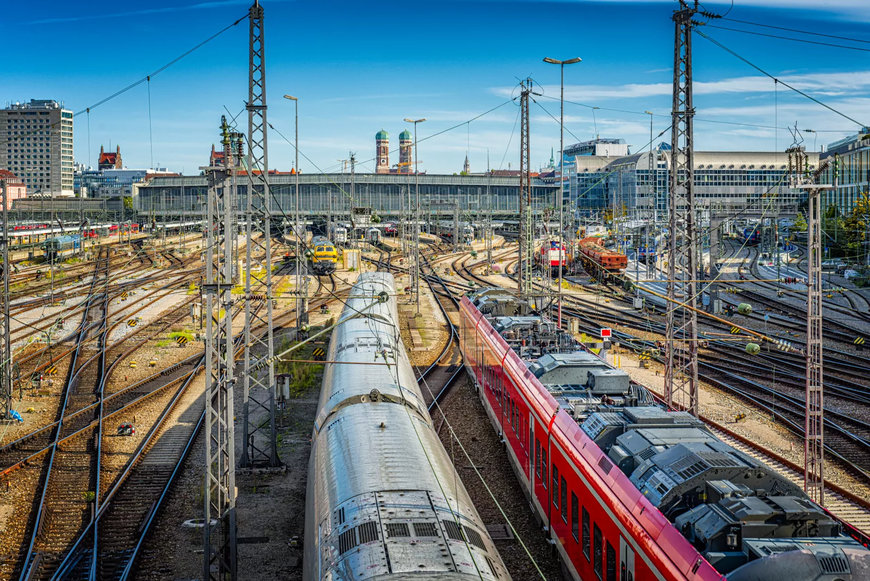railway-international.com
26
'24
Written on Modified on
A new era for railway asset management
Travel by rail is fast, reliable and green.

But it is also susceptible to disruption. Trains cannot steer around obstacles, so a single fault – such as a failed point machine – can cause congestion that spreads across the network, resulting in hours of delays for passengers. Problems are amplified by the fact that diversions are complex and time consuming to organise.
Avoiding incidents and boosting reliability is a huge area of focus for the rail industry. A large national railway network will typically have upwards of 200,000 signalling assets, old and new. Every one of them has the potential to cause disruption. But which ones? And when?
A new maintenance concept
Thales’ new Asset Management System is tailor-made to tackle rail operators’ biggest pain points. First and foremost, it connects to critical assets and enables their centralised monitoring. But it goes further than that. Thanks to our evolved maintenance concept, customers can now use a single platform and a common set of tools to do everything from classic condition monitoring to predictive maintenance and more.
“Connecting assets and doing basic maintenance is just the starting point,” explains Abhay Tiple, Chief Digital Officer, Thales Ground Transportation Systems. “Once that is in place, you can start to deliver data-driven enhancements. This is about being able to anticipate things, not just reacting to problems.”
Connect everything
You can collect data from any type of asset using our new Asset Management System. Point machines, interlockings, Radio Block Centres (RBCs), signals, axle counters and track circuits are examples. You can also gather data from mobile assets, including onboard systems such as Thales’ Modular Communications Gateway (MCG), ETCS Onboard System (OBS) and On Board Integration Framework (OBIF).
In fact, there is no limit to the types of assets you can add to the system. “Having a metadata-driven architecture is the key,” explains Tiple. “This makes it possible to capture functionality, attributes and available actions for any type of asset, old or new.”
The beauty of the new Asset Management System is that you can choose what you monitor, how you monitor it, and adapt the system to the maintenance concept you intend to apply. “What differentiates it from our earlier offerings is that it is modular – customers can manage as much or as little as they choose. So if you only want to manage interlockings and point machines, but not axle counters, you can,” says Tiple.
Powerful functions that get results
As well as choosing the assets you want to monitor, you can choose different levels of functionality to meet your needs. Condition monitoring is a primary capability: data collected from assets is used to generate alerts, track long-term performance and support planning functions. But it doesn’t stop there.
“One of the key points about our Asset Management System is that it gathers all of the data together in one platform in a standardised form,” explains Tiple. “And when you do that, you can start to do some fantastic things on top.”
Creating a digital twin of your network is an example. “Digital twin is a buzzword, but it has real-world implications,” Tiple says. “It allows you to replicate the entire state of your network using real-time data. And once you have that kind of information, you can then run additional services.”
Predictive maintenance is one of them. This is the ultimate troubleshooting tool and it uses data analytics to forecast failures, suggest remedies and even direct maintenance teams to make a timely intervention – before anything goes wrong, enabling traffic to be kept up and running as scheduled.
Operational support is another potential gain. “The system learns dynamically every time a maintenance intervention is made – so you know how long it takes to do a particular job involving a specific asset,” Tiple says. “This has implications for traffic scheduling and maintenance planning, and it underlines the way those insights from the digital twin feed into the operational side of the story.”
Remote software upgrades can also be delivered thanks to digital twin technology. “Our solution offers mass update capabilities – and that can make a real difference when you have a vastly distributed set of assets. You can, for example, have a map view of your assets, do a lasso on the map screen, and upgrade or perform a rollback of the area selected,” explains Tiple. “You can do all of that in the comfort of your operations centre without having to send your operators out there.”
Web-based visualisations are an integral part of the solution. These include maps, charts, graphs and – of course – intuitive tools so users can interact easily with assets, functions and different layers of the architecture. “UX makes all the difference and our customers are really focused on this,” Tiple says. “People expect the same intuitive ergonomics they are used to seeing on their mobile devices.”
Where next?
New sources of data – which include inputs from IoT (Internet of Things) sensor networks and live video feeds from drones – promise to open up further possibilities. “Our customers are interested in adding more sensors – and the more sensors you have, the better digital twinning capability you get,” says Tiple. “The sky’s the limit once you start going in that direction.”
Our new Asset Management System is purpose-built to transform reliability and availability – now and in the future – boosting passenger satisfaction and helping to build a future we can all trust.
www.thalesgroup.com

